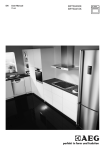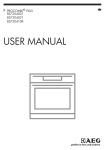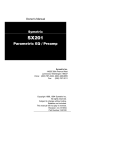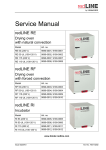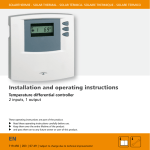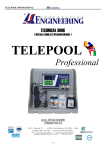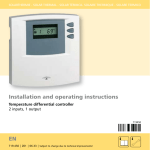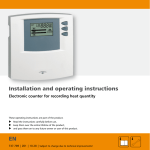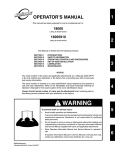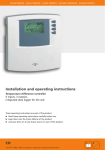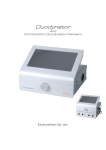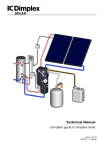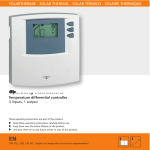Download Installation and operating instructions EN
Transcript
Solar Controller SOLCU1 Installationandoperatinginstructions Temperaturedifferentialcontroller 3 inputs, 1 output speed control 73.81 EN Z03 | Subject to change due to technical improvements! | 87374 – 1 | 08/07 EN Content 1 1.1 1.2 1.3 2 2.1 2.2 About this manual..............................3 Applicability.......................................... 3 Users..................................................... 3 Description of symbols.......................... 4 Safety..................................................5 Proper usage......................................... 5 Improper usage..................................... 5 2.3 2.4 2.5 3 3.1 3.2 4 4.1 4.2 4.3 5 6 Dangers during assembly and commissioning...................................... 6 Detecting faults..................................... 7 Exclusion of liability............................... 7 Description.........................................9 Controller in the solar circuit................. 9 Case overview..................................... 10 Installation . .....................................11 Opening / closing the case.................. 11 Mounting............................................ 12 Electrical connection........................... 13 Display overview..............................17 Commissioning . ..............................18 7 Description of the controller functions...........................................20 7.1 Switch-on / switch-off temperature difference............................................ 20 7.2 Maximum storage tank temperature....20 7.3 Maximum collector temperature........ 21 7.4 Tube collector function....................... 21 7.5 Anti-freeze function............................ 22 7.6 Holiday function.................................. 23 7.7 Speed control...................................... 24 8 Operation..........................................26 8.1 Setting the controller (main menu)..... 26 8.2 Setting the controller (settings menu)...30 9 Maintenance.....................................36 9.1 Fault causes......................................... 36 9.2 Testing the temperature sensor.............39 10 Dismantling and disposal.................41 11 Technical data...................................42 These operating instructions are part of the product. Read these operating instructions carefully before use. Keep them over the entire lifetime of the product and pass them on to any future owner or user of this product. 723.812 | 08.44 EN 1 About this manual 1.1 Applicability This manual describes the installation, commissioning, function, operation, maintenance and dismantling of the temperature differential controller for solar thermal energy systems. When installing the remaining components, e.g. the solar collectors, the pump assemblies and the storage unit, be sure to observe the appropriate installation instructions provided by each manufacturer. 1.2 Users Installation, commissioning, operation, maintenance and dismantling of the controller may only be performed by trained professional personnel. Before commissioning, the controller must be professionally assembled and installed by professional personnel in accordance with the applicable regional and transregional regulations as well as the safety instructions and general instructions within this installation and instruction manual. The professional personnel must be familiar with this operation manual. The controller is maintenance-free. Use the controller only after first thoroughly reading and understanding this instruction manual and the safety instructions. Adhere to all safety instructions. In the event of any ambiguities regarding the operation and alteration of parameters or functions, consult professional personnel. 723.812 | 08.44 EN 1.3 Description of symbols 1.3.1 The structure of the warning notices SIGNAL WORD Type, source and consequences of the danger! Measures for avoiding danger. 1.3.2 Danger levels in warning notices Danger level Probability of occurrence Consequences resulting from non-compliance Imminent Death, serious DANGER threat of danger bodily injury Possible Death, serious WARNING threat of danger bodily injury Possible Minor CAUTION threat of danger bodily injury CAUTION Possible Property damage threat of danger 1.3.3 Notes Note Note on easier and safer working habits. Measures for easier and safer working habits. 723.812 | 08.44 Pictogram with corresponding warning symbol. EN 1.3.4 Other symbols and markings Symbol ✓ • Emphasis on issue at hand Meaning Condition for action Call to action Result of action List Emphasis on issue at hand 2 Safety 2.1 Proper usage The temperature differential controller (below called controller) may only be used for controlling solar thermal systems within the permissible ambient conditions (see chapter 12). 2.2 Improper usage The controller must not be operated in the following environments: • outdoors • in damp rooms • in rooms where highly flammable gas mixtures can occur • in rooms in which the operation of electrical and electronic components may cause dangers to arise 723.812 | 08.44 EN 2.3 Dangers during assembly and commissioning The following dangers exist during assembly / commissioning of the controller and during operation (in case of assembly errors): • risk of death by electrocution • risk of fire due to short-circuit • damage to any of the constructional fire safety measures present in the building due to incorrectly installed cables • damage to the controller and connected devices due to improper ambient conditions, inappropriate power supply and connecting prohibited devices or faulty devices and incorrect assembly or installation Therefore, all safety regulations apply when working on the mains supply. Only electricians may perform work that requires opening the controller (such as connection work). When laying cables, ensure that no damage occurs to any of the constructional fire safety measures present in the building. Make sure that the permissible ambient conditions at the installation site are not exceeded (see chapter 12). Be sure to comply with the specified degree of protection. Factory labels and markings may not be altered, removed or rendered unreadable. 723.812 | 08.44 EN Before connecting the device, make sure that the power supply matches the specifications on the type plate. Make sure that all devices which are connected to the controller conform to the technical data of the controller. Secure the device against unintentional commissioning. All work on an open controller must be performed with the mains supply disconnected. Protect the controller against overloading and short-circuiting. 2.4 Detecting faults Check the display regularly. In case of faults, isolate the cause (see chapter 9). As soon as it becomes evident that safe operation is no longer possible (e.g. visible damage), remove the device from the mains supply immediately. Have professional personnel remedy the fault. 2.5 Exclusion of liability The manufacturer cannot monitor the compliance to this manual as well as the conditions and methods during the installation, operation, usage and maintenance of the controller. Improper installation of the system may result in damage to property and, as a result, in bodily injury. Therefore, we assume no responsibility and liability for 723.812 | 08.44 EN loss, damage or costs which result from or are in any way related to incorrect installation, improper operation, incorrect execution of installation work and incorrect usage and maintenance. Similarly, we assume no responsibility for patent right or other right infringements of third parties caused by usage of this controller. The manufacturer reserves the right to make changes to the product, technical data or assembly and operating instructions without prior notice. 723.812 | 08.44 EN 3 Description 3.1 Controllerinthesolarcircuit 3.1.1 Thepurposeofthecontroller The controller controls with by speed controll the pump in a solar thermal system (see chapter 7 “Description of the controller functions”. 3.1.2 Thestructureofthesolarcircuit Temperature sensor 1 (collector sensor) Temperature difference controller T1 Optional Temperature sensor 3 (upper area of storage tank) Storage tank Collector T3 Solar circuit Pump T2 73.81 | 08.44 Temperature sensor 2 (lower area of storage tank) 9 EN 3.1.3 Thefunctionofthesolarcircuit The controller constantly compares the temperatures between the collector (T1) and the lower area of the storage tank (T). Once the sun heats the collector and there is a temperature difference of 8 K between the collector and the storage tank, the pump is switched on. The pump extracts the heat transfer fluid from the lower cooler area of the storage tank and pumps it to the collector. The heat transfer fluid in the collector is heated by the sun and flows back to the storage tank. The heat transfer fluid heats the domestic water via a heat exchanger located in the storage tank. 3.2 Caseoverview Display Display for controller operation and system settings Operatingswitch The following modes of operation can be selected: Operatingbuttons - On for commissioning and testing for function Arrowup SETbutton - Auto for normal operation Arrowdown - Off to switch-off the pump On Auto Off 10 Connections Grid, pump, temperature sensors 73.81 | 08.44 EN 4 Installation 4.1 Opening / closing the case DANGER Risk of death by electrocution! Hinge grooves Operating buttons Remove the controller from the power supply before opening the case. Make sure that the power supply cannot be unintentionally switched on. Do not damage the case. Only switch the power supply back on after the case has been closed. The top of the case is held in place by two retaining pegs on the upper edge of the bottom half of the case and fastened with a screw. 4.1.1 Opening the case Loosen the screw and remove the upper case in an upward direction. 4.1.2 Closing the case Screw Upper case Lower case Place the upper case over the lower case at an angle. Insert the hinge grooves into the retaining pegs of the lower case. Pivot the upper case down and feed the operating buttons through the matching holes. Fasten the case tightly with the screw. 723.812 | 08.44 11 EN 4.2 Mounting WARNING Risk of electric shock and fire if mounted in a damp environment! Only mount the controller in an area where the degree of protection is sufficient. 4.2.1 Mounting the controller CAUTION Risk of injury and damage to the case when drilling! Do not use the case as a drilling template. Choose a suitable installation site. Drill the upper fastening hole. Screw in the screw. Remove the upper case. Hang the case in the recess . Mark the position of the lower fastening holes ,. Remove the case again. Drill the lower fastening holes. Hang the case up again in the recess . Screw the case firmly using the lower fastening holes and . Mount the upper case. 12 723.812 | 08.44 105 2 3 116 134 137,2 1 EN 4.3 Electrical connection WARNING Risk of death by electrocution! Remove the controller from the power supply before opening the case. Observe all guidelines, lawful and regulations of the local electricity supplier. NOTE The device is to be connected to the grid by means of a plug with earthing contact, or in the case of a fixed electrical installation via a disconnection device for complete disconnection in accordance with the installation guidelines. 4.3.1 Preparing the cable feed Depending on the type of installation, the cables may enter the device through the rear of the case or the lower side of the case. 723.812 | 08.44 13 EN Feeding the cable through the rear of the case (diagram 1): WARNING SET Risk of electrical shock and fire due to cables coming loose! Install an external strain relief for the cables. Remove the plastic flaps from the rear side of the case using an appropriate tool. Feeding the cable through the lower side of the case (diagram 2): 7 Figure 1: Cable feed from the rear WARNING Risk of electrical shock and fire due to cables coming loose! Fasten the cabling to the case using the strain-relief clamps provided. Cut the left and right plastic flaps using an appropriate tool and break them out of the case. 4.3.2 Connecting the cables If a protective conductor is provided or required for the pump, connect the protective conductor to the terminal clamps of the controller. When connecting the protective conductor, observe the following points: - Make sure that the earthing contact is also connected to the controller's mains supply side. 14 SET 723.812 | 08.44 6 Figure 2: Cable feed from below EN Each terminal may only be connected to a single connecting wire (max 2.5 mm2). The Extension Spring Locks to the connection pipes that are accepted are as follows: - single wire (steep): ≤ 2.5 mm² - finely standed conductor (flexible): ≤ 2.5 mm² (the Lacings are to twist with 1 turn to 20 mm) - finely standet conductor (with core cable ends): ≤ 1,5 mm² Only use the original temperature sensor model (Pt1000) that is approved for use with the controller. Observe the following points: - The polarity of the sensor contacts is not important. - Do not lay sensor cables close to 230 volt or 400 volt cables (minimum separation: 100 mm). - If inductive effects are expected, e.g. from heavy current cables, overhead train cables, transformer substations, radio and television devices, amateur radio stations, microwave devices etc., then the sensor cables must be adequately shielded. - Sensor cables may be extended to a maximum length of 100 m. When using extension cables, select the following cable cross sections: - 0.75 mm2 up to 50 m long - 1.5 mm2 up to 100 m long Connect the cables in accordance with the terminal plan. - 723.812 | 08.44 15 EN 4.3.3 Terminal plan N R1 N L1 N R1 N T1 T2 T3 P co rot nd ec uc tive (o to pt G r io rid na 2 l1 3 1 0 (o P 5 V V~ pt u ~ m ) io na p 2 l1 3 15 0 V V ~ ~ ) Te m pe ra tu (lo re w T er em (c sen ol so Te a p re e l m a ra ect r 1 p o of tu (u era st re r) pp tu o s r ra e er e ar sen ge nso ea so ta r 2 nk of r 3 ) st – or o ag pt i e on ta a nk l ) PE PE L 4.3.4 Operation of the connecting terminals NOTE For any handling of the connecting terminal, only adequate tools must be used. Any inadequate tool or mechanical over-pressure will damage the terminal. 16 723.812 | 08.44 EN 5 Display overview 2 1 15 T1 3 14 T1 4 13 T3 max 5 12 ! T2 11 1 2 Symbols of the temperature sensors T1 top = collector sensor T1 bottom = sensor for tube collector function T2 = sensor for lower area of storage tank T3 = sensor for upper area of storage tank Display for temperature values, operating hours and fault symbols, e.g. short circuit, interruption (see page 38) or "SYS" = system error (see page 39) 3 Display for temperature unit °C / °F 4 Operating hours 5 Setting the maximum storage tank temperature (max) and display of min / max temperature values 6 Tube collector function 7 Setting the temperature unit °C / °F 723.812 | 08.44 7 D 10 9 6 8 8 Speed control 9 Holiday function (see page 34) 10 Anti-freeze function (see page 33) 11 Symbols pumping plant and circluation of heat transfer fluid 12 Displays message "Maximum storage tank temperature has been reached" 13 Warning display if faults occur, e.g. short circuit, interruption (see page 38) or "SYS" = system error (see page 39) 14 The maximum temperature of the collector is achieved, so the controllor fluid is eventually evaporated. 15 The display of the starting temperature is achieved, that is “achieved thermal supply” 17 EN 6 Commissioning 6.1 Testing the pump CAUTION Damage to pump caused by dry operation! Make sure that the solar circuit is filled with heat transfer fluid. ✓ The controller case is closed. ✓ All connections are properly made. ✓ The solar energy system is filled. 18 Connect the mains supply. To switch on the pump, set the operating switch to the upper position (on). The display is back lit in red. on appears on the display. After approx. 3 seconds on flashes in alternation with the display. To switch off the pump, set the operating switch to the lower position (off). The display is back lit in red. off appears on the display. After approx. 3 seconds off flashes in alternation with the display. 723.812 | 08.44 T1 T2 on T1 T1 T2 off EN CAUTION The incorrect operating mode may cause the system to shut down or impair proper functioning! T1 After testing the pump, always set the operating switch to automatic operation. To set the controller in automatic operation, move the operating switch to the middle position (Auto). Aut is shown on the display for approx. 3 seconds. Auto 723.812 | 08.44 19 EN 7 Description of the controller functions 7.1 Switch-on / switch-off temperature difference The controller constantly compares the temperatures between the collector (T1) and the lower area of the storage tank (T2). As soon as the temperature in the collector (T1) is 8 K (constant fixed value) higher than the temperature in the storage tank (T2), the following display appears: • The sun symbol is displayed If no safety limits prohibit the pump from operating, the pump is switched on. The following display appears: • The pump symbol rotates If the temperature difference falls below 4 K (constant fixed value), the pump is switched off. The sun symbol is no longer shown on the display. 7.2 Maximum storage tank temperature The maximum storage temperature function is to prevent the hot water tank from overheating. If the lower area of the storage tank (T2) reaches the set maximum storage tank temperature (factory setting of 60 °C), charging is stopped. A temperature of 3 K below the maximum storage tank temperature must first be reached before charging can be resumed. 20 723.812 | 08.44 T2 EN max T2 T1 T1 T1 The following displays appear: • The pump symbol does not move • The sun symbol is displayed • The max indication flashes in the storage tank symbol 7.3 Maximum collector temperature During periods of high solar irradiance, the temperature (T1) of the heat transfer fluid can exceed 130 °C. The heat transfer fluid evaporates. In this case, the pump is blocked for protection purposes until the temperature drops below 127 °C. The following displays appear: • The pump symbol does not move • The sun symbol is displayed • The vapour symbol flashes 7.4 Tube collector function Due to its construction, the collector temperature (T1) can only be inaccurately recorded with vacuum tube collectors (in some cases there are no immersion sensors; or the sensor is outside the collector pipe). In these cases, the solar circuit must be briefly activated at regular intervals to transmit the actual heat from the collector pipe to the sensor (T1). If the tube collector function is activated, the controller automatically switches the pump on every 30 minutes for 30 seconds. The following display appears: • The bottom temperature sensor, T1, is shown 723.812 | 08.44 21 EN 7.5 Anti-freeze function If the anti-freeze function is activated, the controller switches the pump on as soon as the collector temperature T1 falls below +5 °C. The heat transfer fluid is thus pumped through the collector and tries to prevent refreezing. If the collector reaches a temperature of +7 °C, the pump is switched off again. CAUTION System can freeze despite the activated anti-freeze function! During a power outage (the anti-freeze function does not operate). During long-term periods of frost (due to restricted water tank heat storage). If collectors are mounted in locations exposed to wind. It is recommended to generally use the heat carrier fluid with antifreeze for Solar Plants. Standard antifreeze liquid for solar energy systems also contain an additional corrosion inhibitor. The following display appears: T1 • The anti-freeze symbol is displayed D 22 723.812 | 08.44 EN 7.6 Holiday function The holiday function is used to cool down a completely heated storage tank again via the collector. The storage tank can heat up too much, e.g. if no hot water is extracted from the storage tank over an extended period of time (holiday) and intense solar irradiance. A completely heated storage tank subjects the solar energy system to a higher thermal load. If the holiday function is activated, the storage tank is cooled as follows: If the temperature in the storage tank rises up to 10 K below the SET storage tank maximum temperature, the controller attempts to discharge the lower section of the storage tank to 35 °C (e.g. at night). To do so, the pump is automatically switched on once the collector is 8 K colder than the storage tank. If the temperature difference between the collector and the storage tank is only 4 K, the pump is switched off again. T1 The following display appears: • The holiday symbol is displayed 723.812 | 08.44 23 EN 7.7 Speed control NOTE At the factory the controller is set to speed control "on". With this setting, no pump with integrated electronic control should ever be connected to the output. The speed control function controls the settings of the solar circuit pump. Speed control "oFF" | Output as switched output When switched on, the solar circuit pump runs at maximum speed and delivers a constant volume flow (suitable for pumps with integrated electronic control, valves and external relays e.g. for controlling pumps). Speed control "on" | Speed controlled output When switched on, the solar circuit pump runs at a controlled speed and delivers a regulated volume flow (suitable for pumps without integrated electronic control). The following display appears: T1 • The speed control symbol is displayed 24 723.812 | 08.44 EN The speed control function, however, makes a distinction between the "differential temperature control" and "absolute temperature control": - Temperature differential control "diF" The control system attempts to maintain a constant temperature difference between the collector and the storage tank. The solar circuit pump performance is adjusted and the volume flow pumped is increased or reduced, depending on the temperature difference. The specified temperature difference is fixed at 8 K. - Absolute temperature control "AbS" The settings of the solar circuit pump allow the collector temperature sensor T1 to be kept at the absolute temperature as constant as possible so that the storage tank can be charged with the absolute temperature. The absolute temperature can be entered in the setup. 723.812 | 08.44 25 EN 8 Operation CAUTION The incorrect operating mode may cause the system to shut down or impair proper functioning! Make sure that the operating switch is set to automatic operation. 8.1 Setting the controller (main menu) The temperature values of each temperature sensor and operating hours of the pump can be read in the main menu of the display. 26 723.812 | 08.44 EN 8.1.1 Layout of main menu Saved min / max values are deleted and set to the current temperature value min / max temperature values are shown alternately on the display Temperature sensor T1 and the current measured temperature Press for 2 sec. T1 Or automatically after 1 min. Press for 2 sec. Reset SET End of display min Or automatically after 1 min. Press for 2 sec. End of display min Operating hours of the pump Or automatically after 1 min. Press for 2 sec. Or automatically after 1 min. 723.812 | 08.44 End of display Operating hours display flashes 2 sec Operating hours are SET to 0 SET SET Reset SET max 2 sec SET T3 Reset SET max T2 2 sec SET (if available) Temperature sensor T3 and the current measured temperature 2 sec max Temperature sensor T2 and the current measured temperature min SET 27 EN 8.1.2 Display of temperature values NOTE The temperature in the above storage tank is only displayed if the temperature sensor T3 (not included) is also connected. Select temperature sensor (T1, T2 or T3) using the and buttons. The selected temperature sensor and the current measured temperature appear on the display. T1 8.1.3 Display of min / max temperature values ✓ Required temperature sensor is selected. Press the SET button briefly, min / max temperature values are shown alternately on the display. To exit min / max temperature value settings, press or button. T1 T1 8.1.3 Deleting min / max temperature values ✓ Required temperature sensor is selected. 28 Press the SET button briefly, min / max temperature values are shown alternately on the display. Press the SET button for approx. 2 seconds until the temperature values saved are deleted. 723.812 | 08.44 T1 T1 EN T1 T1 The min / max temperatures and the current measured temperature appear on the display. To exit min / max temperature value settings, press or button. 8.1.4 Display of the pump's operating hours Use the or button to select the operating hours of the pump. The operating hours of the pump appear on the display. 8.1.5 Deleting the operating hours of the pump ✓ The operating hours of the pump are selected. Press the SET button briefly. The operating hours flash on the display. Press the SET button for approx. 2 seconds until the operating hours are set to "0". The display shows "0" operating hours. 723.812 | 08.44 29 EN 8.2 Setting the controller (settings°Cmenu) 8.2.1 Layout of settings menus Main menu °F Temperature unit 2 sec SET Chapter 8.2.3 SET 2 sec SET D Chapter 8.2.4 Anti-freeze function D Chapter 8.2.6 2 sec Holiday function 2 sec D Chapter 8.2.7 Chapter 8.2.8 °C 60 60 °C 60 °C °F °F SET * °C °C °C °C °C °C °C °C °CSET °C °C °C °C °C °C °F °F °C °C °F °F SET °C °C60 °F 60 °F °C °C °F °F °C °C °F °F SET °C °C °C °F °F 60 °C 2 sec SET °C 60 60 °C or °C 60 60 °C °C °C °C °C °C SET 2 sec 60 °C 60 °C 60 60 °C °C °C °C °C °C °C °C 723.812 | 08.44 °C 60 2 sec °C °C °C °C °C °C °C 30 °C °F °C Speed control D °C T1 Chapter 8.2.5 60 D D * Note: all temperature values are examples T1 Storage tank maximum temperature 2 sec °C °C °C °F °F °F Tube collector function 2 sec °C °C °C °C SET 60 60 * °C °C °C °C °C SET °C °C EN 8.2.2 Using the settings menus To open the settings menus, press the SET button for approx. 2 seconds. Settings menu "Temperature unit" is displayed. To switch to the next setting, press the button. To exit the settings menus, press the button again until the temperature sensor and temperature reading (main menu) are shown again. 8.2.3 Selecting the temperature unit ✓ The settings menu is open. ✓ Temperature unit "°C" or "°F" flashes. D Press the SET button for approx. 2 seconds to toggle between "°C" and "°F". To exit the settings menu, press the button again until the main menu appears. 8.2.4 Activating the tube collector function NOTE Incorrectly setting the controller can compromise the efficiency of the solar energy system. Therefore, only activate the tube collector function if the construction of the collector does not allow its temperature to be recorded immediately and / or accurately (in some cases there are no immersion sensors; the sensor is outside the collector pipe). 723.812 | 08.44 31 EN ✓ The settings menu is open ✓ Symbols for temperature sensor T1 and tube collector function flash Press the SET button for approx. 2 seconds until top temperature sensor T1 is changed to bottom T1. To exit the settings menu, press the button again until the main menu appears. T1 T1 T2 D 8.2.5 Setting the storage tank maximum temperature DANGER Risk of scalding due to storage tank temperature of over 60 °C! Install a thermostatic mixer in the hot water pipe and set to a maximum 60 °C. ✓ The settings menu is open ✓ The symbols for maximum storage tank temperature and temperature sensor T2 flash 32 Press the SET button for approx. 2 seconds until the temperature indicator flashes. Change the maximum storage tank temperature using the or buttons. To exit the settings menu, press the button again until the main menu appears. 723.812 | 08.44 max T2 D EN 8.2.6 Activating the anti-freeze function CAUTION System can freeze despite the activated anti-freeze function! During a power outage (the anti-freeze function does not operate). During long-term periods of frost (due to restricted water tank heat storage). If collectors are mounted in locations exposed to wind. If frost is expected for a long-term period of time, only operate the system with antifreeze liquid For further information see chapter 7.5. NOTE Incorrectly setting the controller can compromise the efficiency of the solar energy system. Only activate the anti-freeze function for solar energy systems that are not filled with anti-freeze. ✓ The settings menu is open ✓ The symbol for anti-freeze function flashes D Press the SET button for approx. 2 seconds to toggle between "oFF" and "on". To exit the settings menu, press the button again until the main menu appears. 723.812 | 08.44 33 EN 8.2.7 Activating the holiday function ✓ The settings menu is open ✓ The holiday function symbol flashes Press the SET button for approx. 2 seconds to toggle between "oFF" and "on". To exit the settings menu, press the button again until the main menu appears. D 8.2.8 Activating the speed control ✓ The settings menu is open ✓ The speed control symbol flashes Press the SET button for approx. 2 seconds to toggle between "oFF" and "on". Depending on the "oFF" or "on" setting, the following setting options are available: 34 The display shows "oFF": To exit the settings menu, press the main menu appears. button. The The display shows "on": Press the button to access the settings menu in order to select speed control. "diF" or "AbS" flashes on the display. 723.812 | 08.44 D D D EN The speed control function makes a distinction between the "absolute temperature control (AbS)" and "differential temperature control (diF)". Press the SET button for approx. 2 seconds to toggle between "AbS" and "diF". Depending on the "AbS" or "diF" setting, the following setting options are available: T1 T2 D T1 The display shows the setting "diF": To exit the settings menu, press the main menu appears. button. The The display shows the setting "AbS": Press the button to SET the temperature value. D Temperature and AbS flash alternately. Press the SET button for approx. 2 seconds until only the temperature indicator flashes. Change the temperature using the or buttons. To exit the settings menu, press the button. The main menu appears. T1 T1 D D 723.812 | 08.44 35 EN 9 Maintenance The controller was conceived for years of continuous trouble-free operation. Nevertheless, faults may occur. Maintenance may only be performed by professional personnel. In most cases, however, the fault does not lie with the controller, but rather with the peripheral components. The following description covers the most common problems encountered with the controller. Only send in the controller with a precise fault description if none of the following faults are present. 9.1 Fault causes WARNING Risk of death by electrocution! Remove the controller from the power supply before opening the case. Controller does not appear to function at all. Secondary symptoms Possible cause / remedy • The controller display is blank 36 No power supply is present Have professional personnel check the fuse and the supply cable. 723.812 | 08.44 EN The pump, which is connected to the controller, is not running, although its switch-on conditions have been fulfilled. Secondary symptoms • The pump symbol rotates on the display • The pump symbol does not rotate • max indicator flashes • The pump symbol does not rotate Possible cause / remedy The pump connecting cable is not connected, interrupted. If necessary, have professional personnel testing the line. Storage tank full Collector fluid evaporates • Symbol for evaporating collector fluid flashes • The pump symbol does not rotate Operating switch is set to Off • Display is lit with a set the controller operating switch to Automatic. red background • OFF flashes 723.812 | 08.44 37 EN Short-circuit symbol and warning display appear. Secondary symptoms Possible cause / remedy • The pump symbol Short-circuit in the temdoes not rotate perature sensor or its sup• Display background ply cable It is racommended to alternately flashes generally us the heat red and yellow carrier fluid (with anti• The pump stops freeze) for Solar Plants. when there is a short-circuit (its reight for T1 and T2) T1 ! Short-circuit symbol and warning display appear. NOTE In case of T3 short-circuits, the pump does not stop. Interruption symbol and warning signal appear. Secondary symptoms Possible cause / remedy • The pump symbol Temperature sensor T1 or does not rotate T2 or its supply cable is • Display background interrupted It is racommended to alternately flashes generally us the heat red and yellow carrier fluid (with anti• The pump stop with freeze) for Solar Plants. interruption (its reight for T1 and T2) NOTE If T3 is interrupted, no message appears, the pump stop not. 38 723.812 | 08.44 T1 ! Interruption symbol and warning signal appear. EN "SYS" and the warning symbol flash in the controller display. ! "SYS" and the warning symbol flash in the controller display) Possible cause / remedy SYS means there is a system error. This means that, despite the pump running, a temperature difference exceeding 80 K between the collector and the storage tank was recorded. The following causes are possible: • The pump is faulty or not correctly connected. • The isolating valve in the solar circuit is still closed. • There is air in the solar circuit. Since a standard circulation pump cannot eliminate air bubbles inside the piping system, the heat transfer medium circuit comes to a standstill. Have professional personnel check the solar energy system to prevent damage. Once the fault has been remedied, press any button to acknowledge the fault message. 9.2 Testing the temperature sensor 9.2.1 Safety Only professional personnel may test the temperature sensor. 723.812 | 08.44 39 EN 9.2.2 Testing the resistance values DANGER Risk of death by electrocution! Remove the controller from the power supply before opening the case. The temperature is recorded by resistance sensors. These are Pt1000 temperature sensors. Depending on the temperature, the resistance value also changes. A potentially defective sensor can be checked using an ohmmeter. Measuring resistance values 40 Disconnect the corresponding temperature sensor from the controller. Measure the resistance value. The typical resistance values, depending on the temperature, are listed in the following table. Please note that small deviations are permissible. 723.812 | 08.44 EN Temperature sensor resistance values Temperature [°C] -30 -20 -10 0 Resistance [Ω] 882 922 961 1000 1039 1078 Temperature [°C] 30 40 50 60 Resistance [Ω] 1117 1155 1194 1232 1271 1309 Temperature [°C] 90 Resistance [Ω] 1347 1385 1423 1461 1498 1536 Temperature [°C] 150 Resistance [Ω] 1573 1611 1648 1685 100 160 110 170 120 10 70 130 20 80 140 180 10 Dismantling and disposal DANGER Risk of death by electrocution! Remove the controller from the power supply before dismantling the controller. To dismantle the controller, follow the assembly instructions in the reverse order. Dispose of the controller in accordance with the regional regulations. 723.812 | 08.44 41 EN 11 Technical data Temperature differential controller Operational voltage 230 V~ (± 15 %), 50 Hz [optional 115 V (± 15 %), 60 Hz] Own consumption ≤ 1 W Inputs 3 temperature recording (Pt1000) Output 1 1 x triac switched output switching performance max. 250 W [230 V~] Switch-on temperature difference 8 K Switch-off temperature difference 4 K Display LCD display Degree of protection IP 20/DIN 40050 Permitted ambient temperature 0 to +45 °C Mounting wall mounting Weight 250 g Case recyclable 3-piece plastic case Dimensions L x W x H [mm] 137 x 134 x 38 Temperature sensors PT1000 1.5 m silicone cable (measuring range up to +180 °C) Fuse 1,6 AT 3,9 A²s 42 723.812 | 08.44 EN 723.812 | 08.44 43 723.812












































